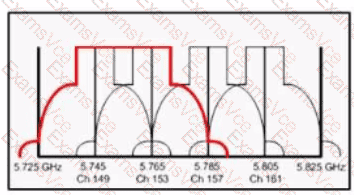Exhibit Analysis:
The diagram shows a section of the 5 GHz Wi-Fi band, with several adjacent channels: 149, 153, 157, 161.
The red line outlines a wider frequency range covering multiple adjacent channels (149, 153, 157).
What this means:
In Wi-Fi (especially 802.11ac/ax), “channel bonding” means combining adjacent 20 MHz channels into a wider channel (40, 80, or even 160 MHz).
The red line indicates the frequency range that would be used if an 80 MHz channel (covering channels 149, 153, 157, 161) is formed by bonding the narrower channels together.
This increases throughput because a wider channel allows more data to be transmitted at once.
Option Review:
A. Practical channel bonding to increase high throughput
Correct. The red line represents the spectrum occupied when several 20 MHz channels are bonded into a single, wider channel to increase data rates.
B. A pool of channels for the wireless radio to broadcast the wireless signal.
Incorrect. A pool would be all available channels, not the bonded range.
C. The range of channels used to allocate available airtime while transmitting data
Incorrect. This is about frequency, not time.
D. The total length of the wireless signal wavelength
Incorrect. The line indicates frequency spectrum, not wavelength length.
Summary:
The red line shows how multiple adjacent 20 MHz channels are bonded together (in this case, most likely into an 80 MHz channel), a practical method to increase wireless throughput in modern Wi-Fi networks.


